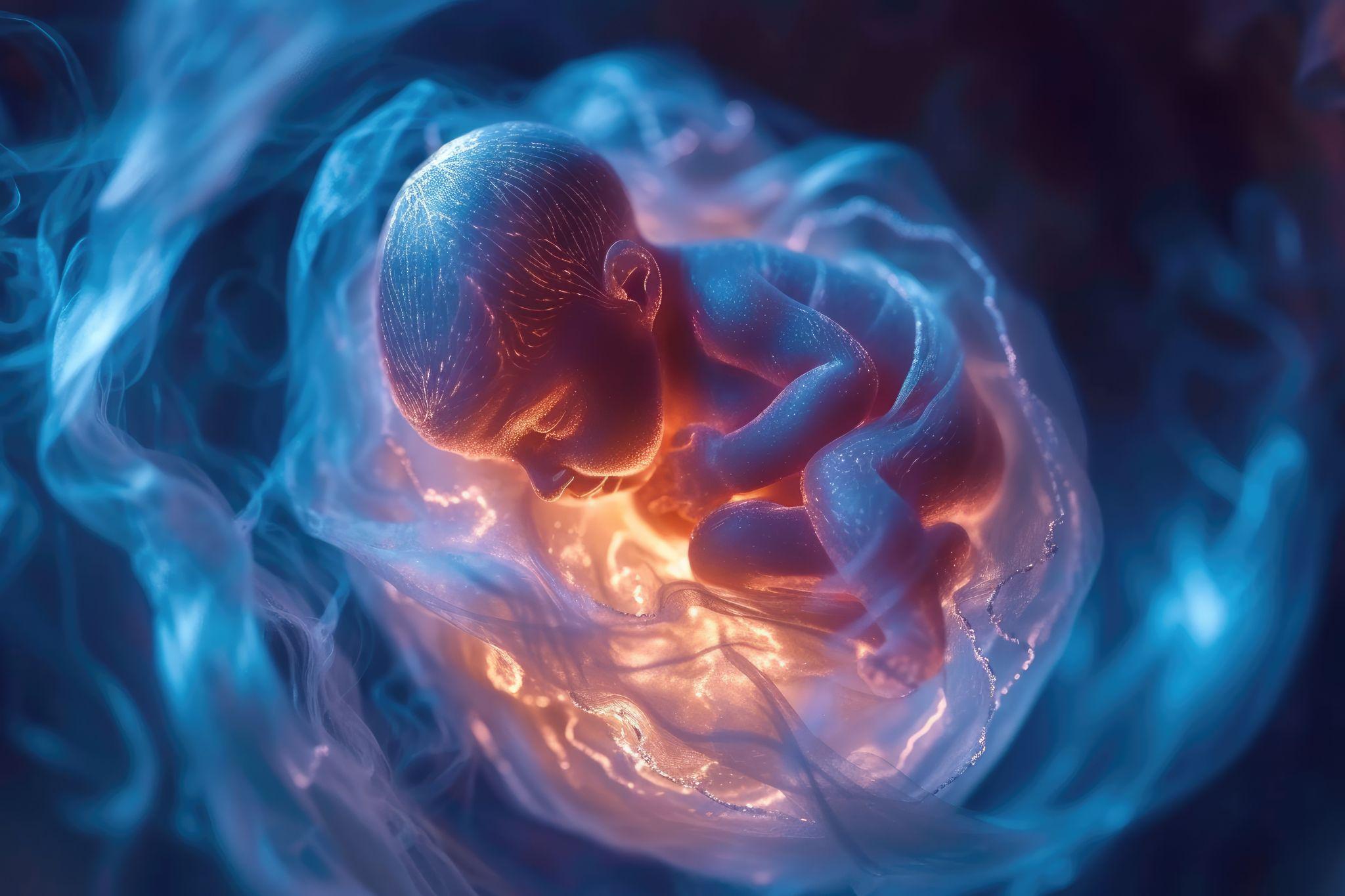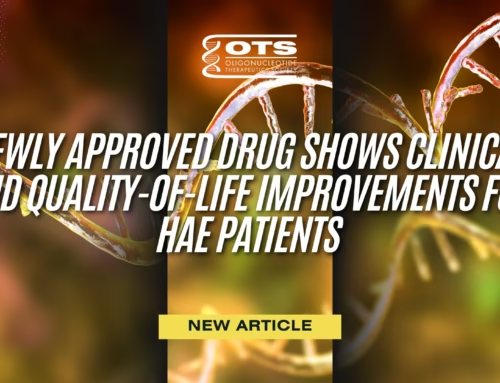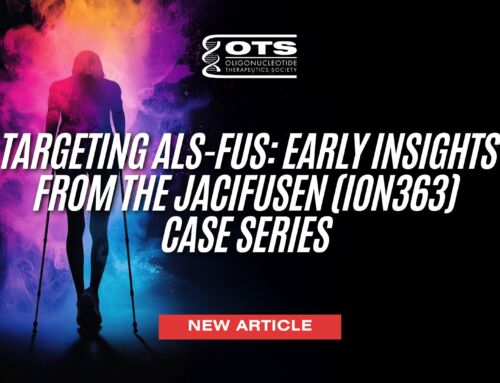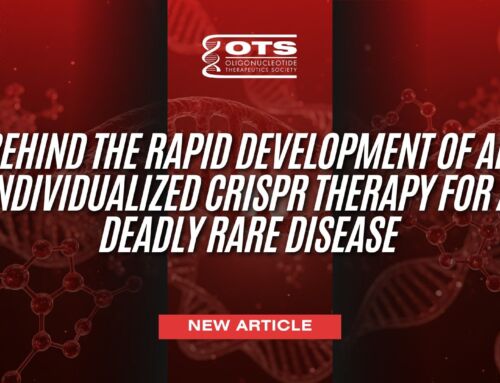Angelman Syndrome Treatment Efforts and a Novel Prenatal Strategy

Imagine finding out your child may never walk, talk, feed, or dress themselves. Never have a job, get married, or have children. Never live independently. This long list of milestones never to be met is the experience for many parents with children diagnosed with Angelman syndrome (AS), a rare, early-onset neurodevelopmental disorder affecting approximately one in 12,000 to 20,000 people globally.
The Angelman syndrome story of Colin, who was born long, lean, and with a headful of blond hair, started when his parents noticed his development wasn’t on track, including not nursing well, severe reflux and constipation, and a weak core that prevented him from holding his head up.
“He didn’t track objects or react to seeing us. He didn’t bring things to his mouth. He didn’t play with toys. His reflexes weren’t integrating. He didn’t coo or babble. He rarely ever slept,” wrote his mom Kelly.
After six months of advocating to see specialists and trying to find a diagnosis for Colin, the family was able to get a last-minute genetics appointment where he had his blood drawn. Two months later, they received the results that he had Angelman syndrome.
Characterized by developmental delays, intellectual disabilities, seizures, impaired speech, and behavioral, movement, and balance problems, the disease typically results from the disruption of the maternal UBE3A gene located on chromosome 15. The paternal UBE3A allele is silenced in neurons by the UBE3A antisense transcript (UBE3A-AS), so disruption of the maternal copy means there are no working copies of the gene in certain parts of the brain.
Colin’s parents sat there in shock as they were told that long list of things their son would never do. Worst of all, Kelly wrote, there isn’t a cure. The current treatment focuses on symptom management, using anti-seizure medication and physical therapy, but does not address the root cause of the disease, which severely affects both the patient’s and caregiver’s quality of life. According to a study from the Netherlands, emotional and behavioral issues are the primary symptoms that predict a lower quality of life. These issues, combined with a child’s sleep problems, were found to have the most significant influence on parental caregivers’ time, anxiety, and stress.
The Netherlands study found that patients’ quality of life was classified as “exceptionally low” to “low average” relative to healthy children and suggests that interventions should focus on both the child and the parents in a systemic approach. For Kelly and her husband Brian, finding the Foundation for Angelman Syndrome Therapeutics (FAST), which hosts an annual summit and gala with updates on Angelman research, was transformative. Recent research exploring the possibility of halting the disease while the child is still in utero, as well as therapies in clinical phases, also holds the potential to change the course of those with Angelman syndrome.
Novel prenatal treatment of Angelman syndrome allows less invasive delivery
Prenatal delivery of an antisense oligonucleotide (ASO) could offer a novel strategy for early treatment of Angelman syndrome, and a study published in Molecular Therapy this past April used mouse models of the disease to test if this could work (1). With previous research showing it’s not only possible to diagnose Angelman syndrome before birth but also to interfere with the expression of the mutated gene section prenatally, the study hypothesized that prenatal delivery of an ASO, either by intracranial (IC) injection or intra-amniotic (IA) injection, could rescue the paternal UBE3A expression in a mouse model (1).
The study — led by researchers at the University of California, San Francisco — found that in utero, IC injection of the ASO resulted in dose-dependent activation of the paternal UBE3A, with broad biodistribution in a mouse model with a UBE3A-YFP allele. To investigate a less invasive method of administration, the researchers next looked at how IA injection could reach the brain and found that it also resulted in systemic biodistribution and high levels of UBE3A reactivation throughout the brain.
The results show that injecting the ASO directly into the amniotic fluid permits a higher dose than IC injection. This was supported by using miRNA scope in situ hybridization (ISH) that revealed after intra-amniotic injection the ASO was widely distributed throughout the body and brain, and reinstated gene expression of UBE3A, allowing the therapy to target deep brain regions critical to treating Angelman syndrome (1).
Loss of UBE3A affects neurons in all brain regions, specifically the cortex and hippocampus, causing severe functional impairments. Therefore, the study states, that the findings of widespread ASO distribution in the central nervous system (CNS), UBE3A reinstatement in critical brain regions, along with behavioral testing results, suggest a potential for therapeutic benefits in humans. Additionally, the motor learning impairments, which are a severe symptom for those with AS, were improved in the mouse model (1).
“These findings offer a novel strategy for early treatment of AS using an ASO, with two potential routes of administration in the prenatal window. Beyond AS, successful delivery of a therapeutic ASO into neurons has implications for a clinically feasible prenatal treatment for numerous neurodevelopmental disorders,” the study states.
Tippi MacKenzie, senior author of the study, noted in a recent article that ASOs are currently given to children with diseases affecting the nervous system, but children with a severe version of a genetic condition may have irreversible damage by the time they are born that cannot be addressed after birth. The possibility for less invasive, in-utero treatment of genetic conditions like Angelman syndrome could potentially help prevent the onset of irreversible organ damage and allow access to neurons when the blood-brain barrier is more permeable.
The researchers are now working with a larger animal model to determine if ASOs can be delivered prenatally into the CNS as effectively as they were in mice. They are also communicating with parents whose children have AS and other related genetic disorders to understand their thoughts on prenatal therapy.
Angelman syndrome drugs: Ultragenyx and Ionis competing for successful ASO treatment
Few industry efforts have been made to treat Angelman syndrome, and in the case of Swiss pharmaceutical company Roche, the efforts led to disappointing data and, ultimately, the company dropping the drug development. Roche’s ASO for Angelman syndrome, rugonersen, began a clinical trial in 2020 and, despite being well tolerated with an acceptable safety profile, did not make it past the phase 1 trial due to its lack of significant efficacy. However, pharmaceutical companies Ultragenyx and Ionis are still testing ASOs to treat the rare disease.
Biotech company Ultragenyx reported in April that its ASO treatment GTX-102, designed to treat Angelman syndrome, was generally safe and led to rapid and clinically meaningful improvements in cognition, communication, and sleep exceeding that of natural history data. While its Phase 1/2 update did not provide specific data, Ultragenyx said the cognitive improvements were accompanied by strong behavioral, sleep, hyperactivity, gross motor, and receptive communication improvements after GTX-102 treatment.
Trial participants included children 4-17 years old, all who received GTX-102 in an open-label trial without a control group. There were no unexpected serious adverse effects, although three participants experienced some lower extremity weakness, which rapidly resolved and did not disrupt their ability to continue treatment. Although the lower extremity weakness previously led to a clinical hold in 2020, the hold was lifted in 2021 after the study’s protocol was changed to narrow the dose range and switch to intrathecal administration, and the FDA and other regulatory groups didn’t raise it as an issue this time.
Ultragenyx CMO Eric Crombez stated in the press release that the interim data shows treatment with GTX-102 resulted in rapid, multi-domain improvement that continued throughout maintenance dosing, which could have a meaningful impact on patients and their families. Notably, some children have been able to start eating on their own and communicating with their families.
GTX-102 works by targeting and blocking the expression of the UBE3A-AS gene, which otherwise creates a protein that silences the paternal copy of UBE3A. The therapy aims to produce a functional UBE3A protein by allowing expression of the paternal gene, thus easing disease symptoms.
These promising results encouraged the European Medicines Agency (EMA) to grant GTX-102 a Priority Medicine designation (PRIME), which is given to support developers of promising medicines that show significant therapeutic benefits to patients with limited options. Crombez said its next step will be an end of Phase II FDA meeting to allow for the timely initiation of a Phase III pivotal study.
Meanwhile, Ionis – in collaboration with Biogen – is also developing an ASO for Angelman syndrome known as ION582. This drug works like GTX-102 in un-silencing the paternal copy of the UBE3A gene. In June 2022, the drug won the FDA’s Orphan Drug and Rare Pediatric Disease designation, and in November 2023, Ionis shared a positive clinical update of its open-label HALOS trial, in which all patients received the active drug.
The update noted that ION582 had been generally well tolerated at all dose levels, and participants (aged 2-50 years old) were continuing to Part II, the long-term extension portion of the study. Additionally, one month after the last Part I dose, clinical findings found that most patients had improved electroencephalography (EEG) activity.
“Angelman syndrome is characterized by an increase in slow Delta brain wave activity,” the update states. “Approximately 70% of patients showed a reduction in slow-wave EEG delta activity, and over 80% showed an increase in faster frequency rhythms.” These changes exceed what was observed in natural history studies during the same time period. The majority of patients also experienced an improvement in overall functioning and clinical functioning, and adverse events were consistent with patients’ medical histories, Angelman diagnosis, or intrathecal (spinal canal) administration.
The future of treating Angelman syndrome and other rare conditions
There is a high unmet need for developing treatment for rare diseases, of which over 90% have no targeted therapy available (2). As 70-80% of these rare disorders are caused by pathogenic genetic alterations in single genes, ASO-based drugs could potentially provide disease-modifying therapies for many of these conditions (2). The versatility of ASOs means they can be designed to specifically target and modify RNA transcripts to slow down or stop rare disease progression while also offering the potential to target groups of patients or be tailored to individual cases (2).
While delivering an ASO therapy prenatally is still in its early stages, Angelman syndrome is not the first neurodevelopmental disease to show success in preclinical models of in-utero delivery. Prenatal applications of ASOs have also demonstrated success in a mouse model of Usher syndrome, a rare genetic disease that affects hearing and vision (1). Additionally, spinal muscular atrophy — a life-threatening disease that causes progressive muscle weakness and atrophy — has also undergone mouse model trials of in-utero gene therapy (3). A 2021 paper published in Clinical Obstetrics and Gynecology states that prenatal injection of human amniotic fluid stem cells showed better survival and marked improvement in motor neuron function in mice with SMA compared to the untreated group (3).
“Although these animal models are promising proof of concepts, much work is yet to be done before this concept translates into treatment during human pregnancy,” the study states.
More recently, a team of researchers at UC Davis has been working on a gene-editing therapy for Duchenne muscular dystrophy that would allow pregnant mothers to give birth to children free from the disease. “Gene editing provides a permanent cure as it is a correction of the mutation,” Aijun Wang, the lead researcher, explained in a recent article. “When the treatment is offered before birth, and if it is done right with the mutation efficiently edited, one can prevent the disease from happening.”
For Angelman children like Colin, who took his first steps before his fourth birthday — a milestone that was never guaranteed — the research and clinical trials are encouraging. While Kelly says they don’t know what his future holds, they are hopeful for a better quality of life for Colin and all individuals with Angelman syndrome.
References
- Clarke MT, Remesal L, Lentz L, Tan DJ, Young D, Thapa S, Namuduri SR, Borges B, Kirn G, Valencia J, Lopez ME, Lui JH, Shiow LR, Dindot S, Villeda S, Sanders SJ, MacKenzie TC. Prenatal delivery of a therapeutic antisense oligonucleotide achieves broad biodistribution in the brain and ameliorates Angelman syndrome phenotype in mice. Mol Ther. 2024 Apr 3;32(4):935-951. doi: 10.1016/j.ymthe.2024.02.004. Epub 2024 Feb 6. PMID: 38327047.
- Lauffer, M.C., van Roon-Mom, W., Aartsma-Rus, A. et al. Possibilities and limitations of antisense oligonucleotide therapies for the treatment of monogenic disorders. Commun Med 4, 6 (2024). https://doi.org/10.1038/s43856-023-00419-1
- Baptiste, Caitlin MD; De Vivo, Darryl C. MD. Spinal Muscular Atrophy: A Potential Target for In Utero Therapy. Clinical Obstetrics and Gynecology 64(4):p 917-925, December 2021. | DOI: 10.1097/GRF.0000000000000654








